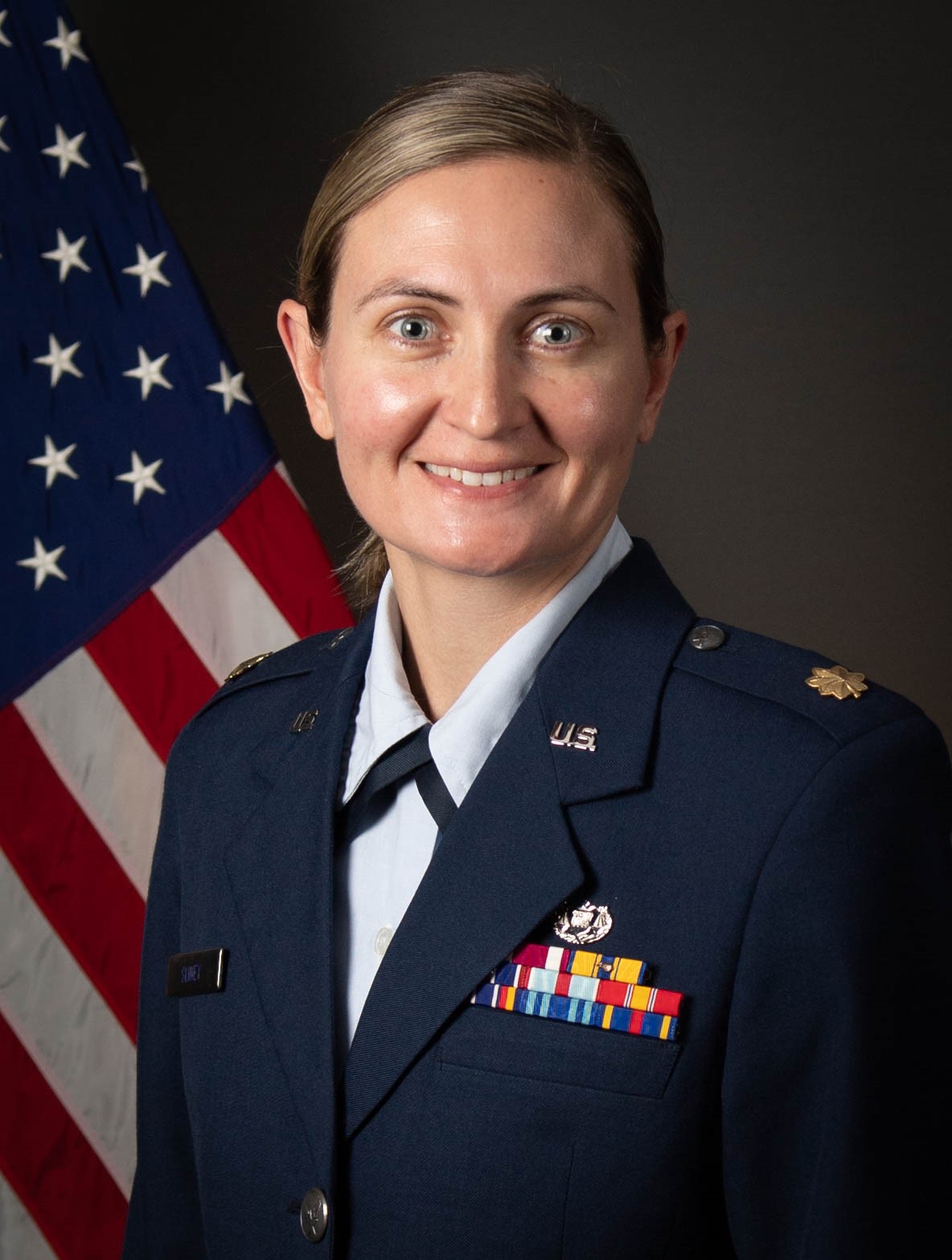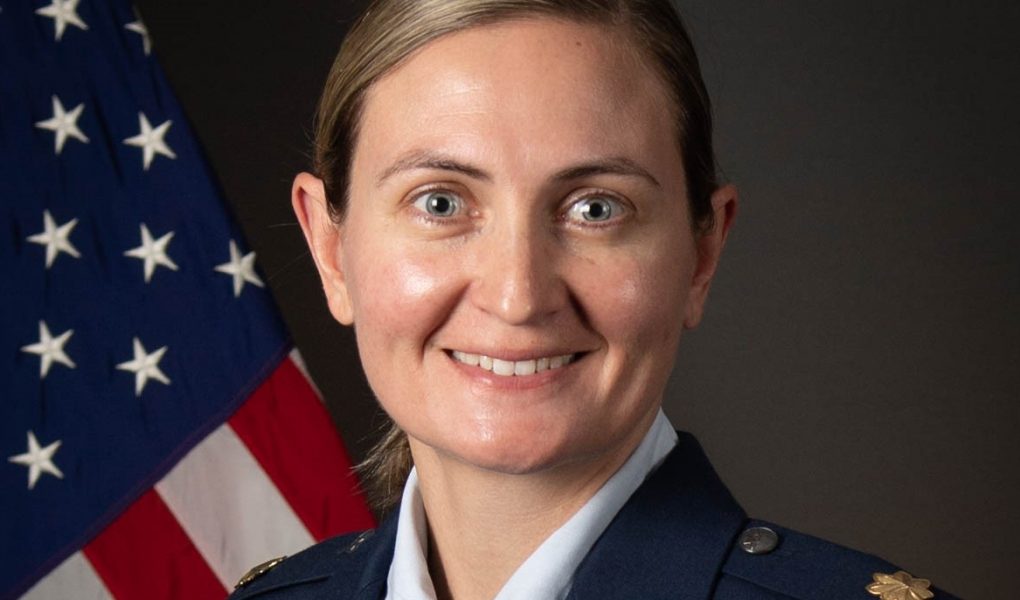
Major Samantha Arrington Sliney is a U.S. Air Force Judge Advocate (JAG). She earned her Juris Doctor degree from the University of North Carolina Central School of Law in 2013 and her Masters of Laws in Homeland and National Security from Western Michigan University Cooley Law School in 2016. She is currently the North Carolina Association of Women Attorneys President, the Military Spouse Juris Doctor Network Pro Bono Committee Director, a Phi Alpha Delta Law Fraternity Disciplinary Committee member, and the faculty advisor for the Homeland and National Security Law Review. As a Department of the Air Force Women’s Initiatives Team Co-Chair, she serves as the primary force in vital policy changes regarding women’s issues.
Autumn Wong: Why, of all the career tracks available in the Air Force, did you choose to pursue law?
Major Sam Sliney: My path is not traditional. I wanted to be a journalist rather than a lawyer. I had my first glimpse at law during a class about the First Amendment. The pre-law advisor for my school taught the course and spoke to me about minoring in Legal Studies. I learned very quickly that because my husband–boyfriend at the time–was in the military, it would be very hard to pursue a career in journalism. I was not going to be stationed in any areas, such as Los Angeles or New York City, that would provide ample journalism opportunities. So, I decided to pursue law school.
I found the idea of doing the same thing every day to be boring so I looked to see what the military had to offer. Being a Judge Advocate (JAG) is much more than just being a lawyer. We are expected to be a jack-of-all-trades. I serve in a variety of jobs: a prosecutor, defense attorney, and advisor on operational, international, and administrative law. There is a lot of independence very early on, which is not always the case in other sectors. Much of it goes back to public service and my inclination to serve. I have the opportunity to give back by serving our Nation, our military members and their dependents.
How does your work as a JAG intersect with the Women’s Initiative Team (WIT)?
Lawyers are advocates. A lot of what we do on the Women’s Initiative Team is advocating to eliminate barriers to women’s service through policy change. I started volunteering in 2019 to identify and eliminate barriers to women’s propensity to serve in the Department of the Air Force and Department of Defense. For example, the WIT advocated for and won approval for Permissive Temporary Duty travel (PTDY) [authorized administrative absence] for infertility treatment. Prior to that, Airmen and Guardians had to take their own personal leave to seek treatment outside the local area. We were preliminarily told that this would be approved but had to wait an entire year for it to officially go into the Air Force Instruction (AFI). We kept advocating and telling people that we have service members that need this now.
Another example is the recent hair policy change. We are now able to wear ponytails and have some flexibility with how women wear their hair, rather than just wearing a bob or bun. That took five years. That to me is very sad, especially when wearing a bun is not tied to any operational or safety needs. In fact, when women fly aircraft or put on gear for chemical warfare, they would have to take their bun down. I think we are headed in the right direction. But the Department of the Air Force and the Department of Defense are big, bureaucratic entities. Before my time joining the WIT, I struggled with the bureaucracy and how to make a large-scale impact in it. The WIT helped me to see that I can make a change with self-advocacy.
What is the policy change process to make it more inclusive of women?
I will speak about the regulation that was amended to include reimbursement for breast milk transportation. This Joint Travel Regulation governs all travel within the Department of Defense. This impacts all Uniformed Services: the traditional Service branches, but also the Public Health Service and National Oceanic and Atmospheric Administration. This change focused on supporting working mothers separated from their infants while on official travel. The Department of Defense supports breastfeeding, with required lactation spaces, TRICARE-covered breast pump and supplies, and storage at work for milk, but did not provide support to get it back home to the baby while a mother was traveling for work.
I identified the problem when I had this dilemma myself. There is a regulation that states new mothers, within the first year of birth, do not have to travel for work, if they choose. But in the role I was in at the time, there was no way for me to do my job and not travel. It became a question of “Am I stalling my career?”
From there, the WIT got to work. We found out that the authority was already there, but the Joint Travel Regulation had to be specifically worded to allow it. We built a 20-page proposal paper explaining why this change was the important last puzzle piece of lactation support. It outlined how this regulation change tied into the national defense, national security, and Air Force retention strategies.
We also had to show that there were women that could benefit from this. I think the best story I have from that part is when I approached the Navy. The first pushback I got was, “Women sailors do not need this. They do not utilize Temporary Duty Travel within the first year of birth.” But, I had already collected data from the Defense Manpower Data Center that showed that eighteen percent of women sailors did go on Temporary Duty orders within the first year of birth. That piece changed their tune a little bit.
We started our roadshow and briefed key stakeholders: the medical community, Defense Health Agency, Public Health Service, Air Force, Army, Coast Guard, and Navy. Each stakeholder was a gatekeeper because they controlled the process to propose a Joint Travel Regulation change. Finally, after two years of roadshows and advocacy, we had enough backing to know that the proposal would be approved if officially presented for decision. From that point, it took another seven months for the official change to be approved. Sometimes, I think that people forget that there are real people at the other end of these policy changes, and that something very simple, like covering the cost of shipping breast milk, can impact them in such a dramatic way.
We do a lot of “red teaming” in the military. We always try to stay three steps ahead of what we think people will say. It is asking the hard questions of each other. For example, “Why do we need this?” because we know going in that not everyone will be supportive of some of these changes, especially changes that cost money. And this one was going to cost the Services and Department of Defense money. It took a little over two and a half years and we were able to finally change the Joint Travel Regulation.
In the two to five years that it takes to change Air Force policy, what keeps you motivated?
I have two children: a two-year-old boy and a four-year-old girl. Statistically, given that both of their parents serve in the military, the likelihood of one of them serving is fairly high. Regardless of whether it is my daughter or son that decides to serve, I do not want them to have to worry about any of these barriers. I want to make a better Department of the Air Force and Department of Defense for them.
Furthermore, the WIT keeps me going. I am surrounded by a group of people who are like-minded and uplift me in hard moments. When we have wins, we celebrate them, even the little ones. Rarely do we make huge, monumental changes all at once. We always say that we are “chipping away at the iceberg” with each policy change. When we do get policy approvals it shows that people at high levels actually listen and care for our Airmen. Similarly, when service members thank you for what you are doing, it boosts your confidence. I have had Airmen come up to me and say, “Hey, the change you made enabled me to continue to serve.” There is no better feeling in the world than to know that you help somebody along their service journey.
What is your advice for self-advocacy within bureaucratic institutions?
Be well researched. If you advocate for yourself, you must have the facts to back it up. In the Air Force, if you feel like you are being wronged in some way, go look at the Air Force Instruction (AFI). If an Airman just had a baby and her unit is not providing a lactation room, go to the AFI that states that a lactation space is required and use that as data.
It can be very intimidating, especially for an Airman to go to their superior, who is often a master sergeant or even their Commander, to say, “I have not been given what I need to be given to be successful.” But if you have the regulation and data, then it’s harder for someone to tell you “no.” They may not be able to fix it for you but you are setting the stage for the people that come in the future. Remember that the right thing is not always the easiest thing to do. It can be easy, especially as a junior Airman, to say, “There is nothing I can do about this.” That is the easy out. Taking the personal courage to stand up for the right thing is usually, in the long run, the best thing that you can do.
One of my mantras is “Don’t walk past a problem.” For example, Major Megan Biles, my WIT Co-Chair, does not have children, but most of the initiatives she works on relate to pregnancy and having kids. People like her inspire me because she does this despite the fact it does not benefit her personally. She does it because it is the right thing to do. A lot of the time, our male Airmen ask, “How can I help with women’s issues?” Our biggest allies are men. Just because it does not impact you personally does not mean that you cannot effectuate change. We need everyone to see these as not just as women’s issues but as Airmen and Guardian issues.
*This interview has been edited for length and clarity.




